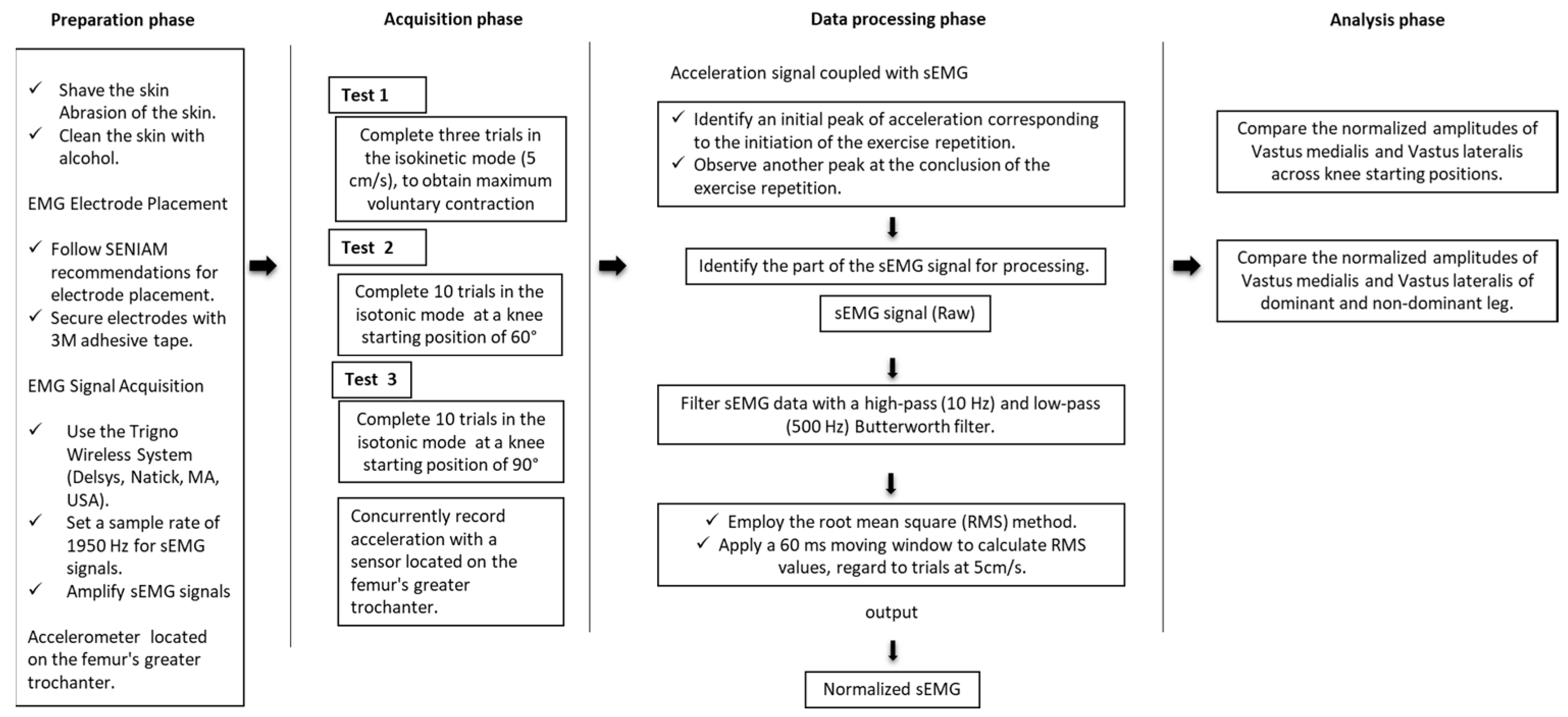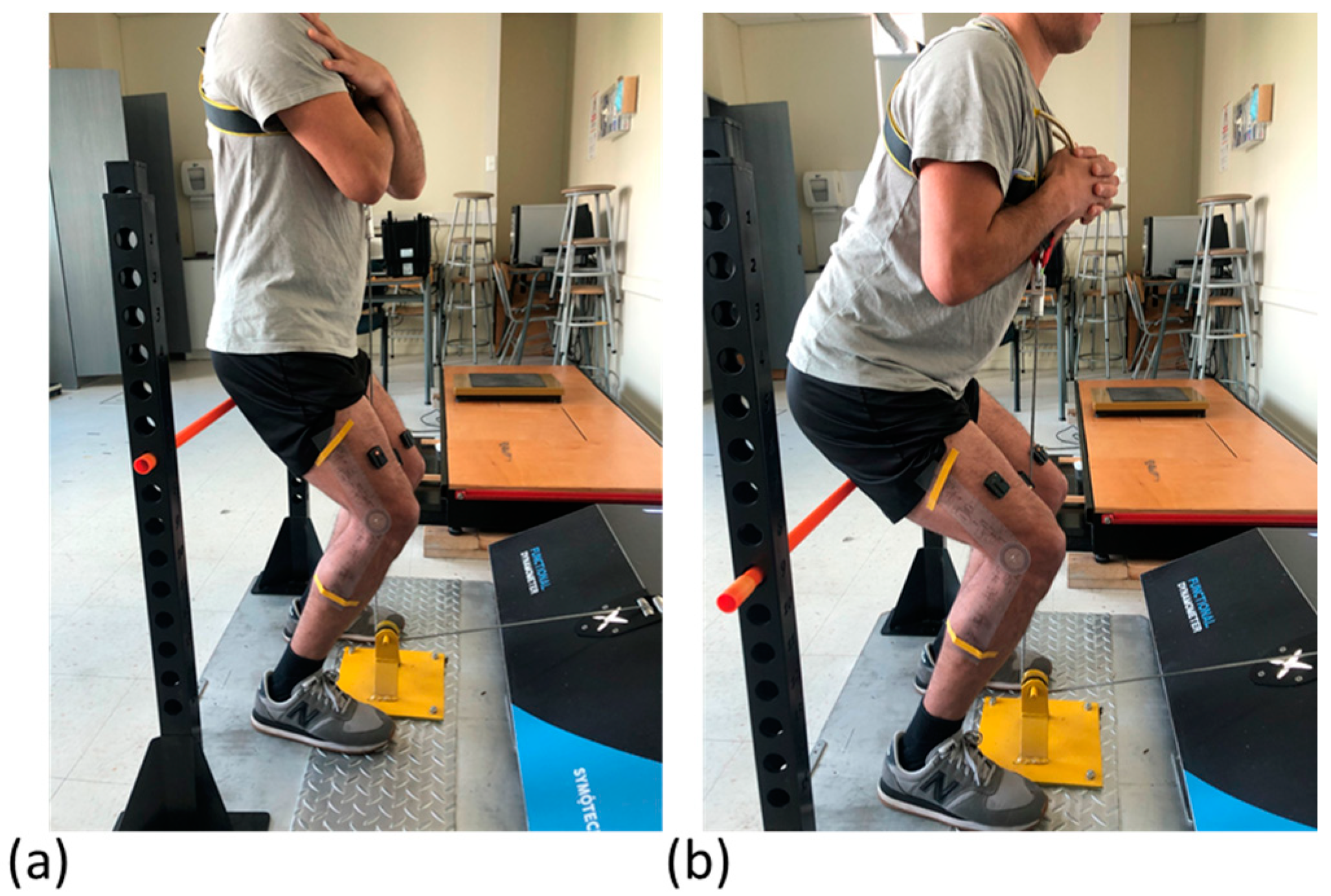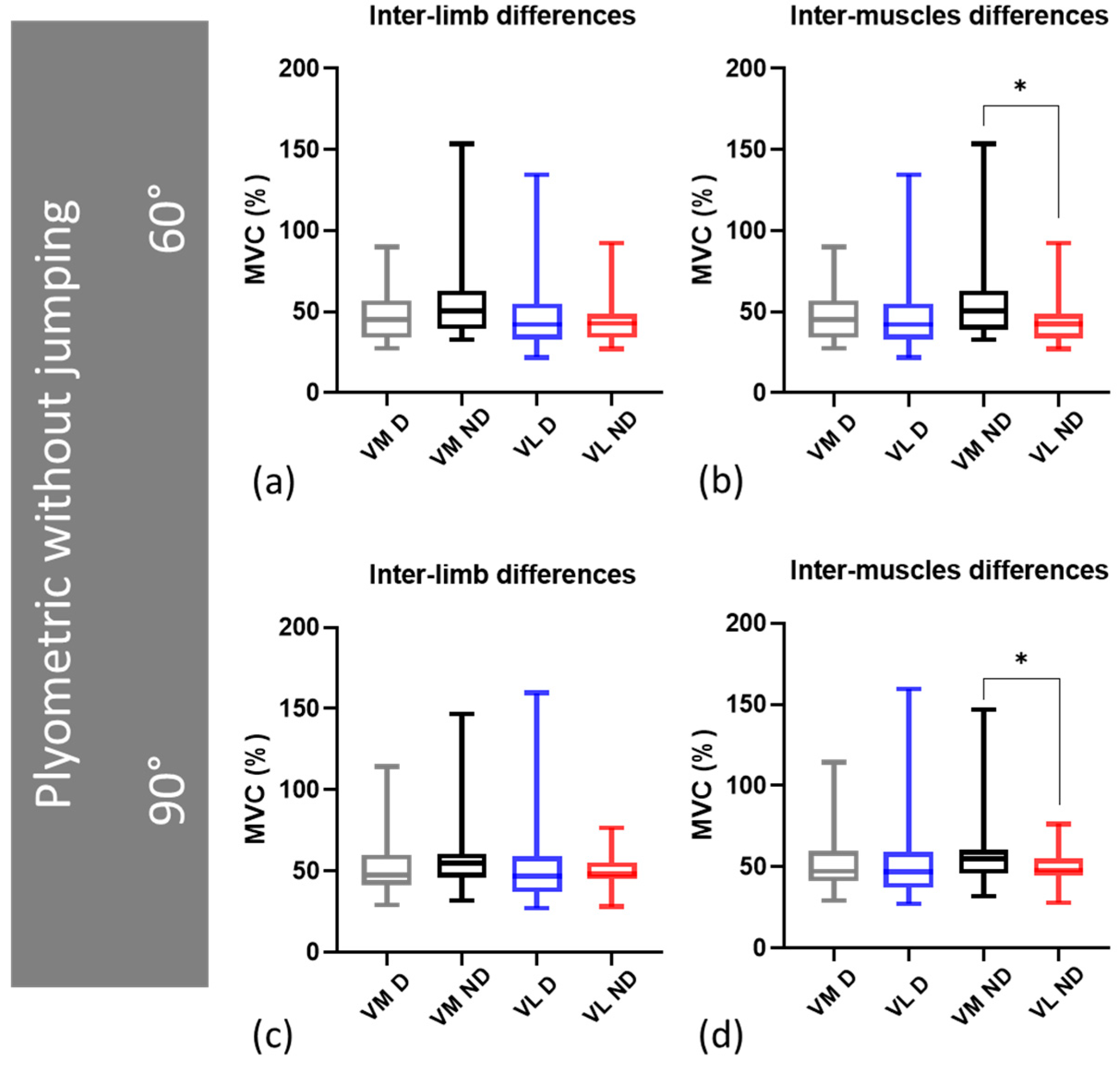Impact of Starting Knee Flexion Angle on Muscle Activity and Performance during Plyometrics without Jumping
Abstract
1. Introduction
2. Materials and Methods
2.1. Experimental Design
2.2. Participants
2.3. Data Recordings
2.3.1. Anthropometric Assessment
2.3.2. Resisted Plyometric without Jumping Evaluation
2.3.3. Surface Electromyography (sEMG) (Figure 2)

2.4. Statistical Analyses
3. Results
4. Discussion
5. Conclusions
Author Contributions
Funding
Institutional Review Board Statement
Informed Consent Statement
Data Availability Statement
Acknowledgments
Conflicts of Interest
References
- Davies, G.; Riemann, B.L.; Manske, R. Current Concepts of Plyometric Exercise. Int. J. Sports Phys. Ther. 2015, 10, 760–786. [Google Scholar] [PubMed]
- Behm, D.G.; Young, J.D.; Whitten, J.H.D.; Reid, J.C.; Quigley, P.J.; Low, J.; Li, Y.; Lima, C.D.; Hodgson, D.D.; Chaouachi, A.; et al. Effectiveness of Traditional Strength vs. Power Training on Muscle Strength, Power and Speed with Youth: A Systematic Review and Meta-Analysis. Front. Physiol. 2017, 8, 423. [Google Scholar] [CrossRef] [PubMed]
- Ramirez-Campillo, R.; Moran, J.; Oliver, J.L.; Pedley, J.S.; Lloyd, R.S.; Granacher, U. Programming Plyometric-Jump Training in Soccer: A Review. Sports 2022, 10, 94. [Google Scholar] [CrossRef] [PubMed]
- Slimani, M.; Chamari, K.; Miarka, B.; Del Vecchio, F.B.; Cheour, F. Effects of Plyometric Training on Physical Fitness in Team Sport Athletes: A Systematic Review. J. Hum. Kinet. 2016, 53, 231–247. [Google Scholar] [CrossRef] [PubMed]
- Ramirez-Campillo, R.; Moran, J.; Chaabene, H.; Granacher, U.; Behm, D.G.; García-Hermoso, A.; Izquierdo, M. Methodological characteristics and future directions for plyometric jump training research: A scoping review update. Scand. J. Med. Sci. Sports 2020, 30, 983–997. [Google Scholar] [CrossRef] [PubMed]
- Wyon, M.; Harris, J.; Brown, D.; Clark, F. Bilateral differences in peak force, power, and maximum plié depth during multiple grande jetés. Med. Probl. Perform. Art 2013, 28, 28–32. [Google Scholar] [CrossRef] [PubMed]
- Tatlıcıoğlu, E.; Atalağ, O.; Kırmızıgil, B.; Kurt, C.; Acar, M.F. Side-to-side asymmetry in lower limb strength and hamstring-quadriceps strength ratio among collegiate American football players. J. Phys. Ther. Sci. 2019, 31, 884–888. [Google Scholar] [CrossRef]
- Guan, Y.; Bredin, S.S.D.; Taunton, J.; Jiang, Q.; Wu, N.; Li, Y.; Warburton, D.E.R. Risk Factors for Non-Contact Lower-Limb Injury: A Retrospective Survey in Pediatric-Age Athletes. J. Clin. Med. 2021, 10, 3171. [Google Scholar] [CrossRef]
- Bond, C.W.; Cook, S.B.; Swartz, E.E.; Laroche, D.P. Asymmetry of lower extremity force and muscle activation during knee extension and functional tasks. Muscle Nerve 2017, 56, 495–504. [Google Scholar] [CrossRef]
- Jerez-Mayorga, D.; Huerta-Ojeda, Á.; Chirosa-Ríos, L.J.; Guede-Rojas, F.; Guzmán-Guzmán, I.P.; Intelangelo, L.; Miranda-Fuentes, C.; Delgado-Floody, P. Test-Retest Reliability of Functional Electromechanical Dynamometer on Five Sit-to-Stand Measures in Healthy Young Adults. Int. J. Environ. Res. Public Health 2021, 18, 6829. [Google Scholar] [CrossRef]
- González-Izal, M.; Malanda, A.; Gorostiaga, E.; Izquierdo, M. Electromyographic models to assess muscle fatigue. J. Electromyogr. Kinesiol. 2012, 22, 501–512. [Google Scholar] [CrossRef] [PubMed]
- Korak, J.A.; Bruininks, B.D.; Paquette, M.R. The Influence of Normalization Technique on Between-Muscle Activation during a Back-Squat. Int. J. Exerc. Sci. 2020, 13, 1098–1107. [Google Scholar]
- Maddox, E.U.; Bennett, H.J.; Weinhandl, J.T. Evidence for the use of dynamic maximum normalization method of muscle activation during weighted back squats. J. Biomech. 2022, 135, 111029. [Google Scholar] [CrossRef] [PubMed]
- Barrett, K.B.; Sievert, Z.A.; Bennett, H.J. A Comparison of Squat Depth and Sex on Knee Kinematics and Muscle Activation. J. Biomech. Eng. 2023, 145, 071010. [Google Scholar] [CrossRef] [PubMed]
- Jaberzadeh, S.; Yeo, D.; Zoghi, M. The Effect of Altering Knee Position and Squat Depth on VMO: VL EMG Ratio During Squat Exercises. Physiother. Res. Int. 2016, 21, 164–173. [Google Scholar] [CrossRef] [PubMed]
- Whitcomb, E.; Ortiz, O.; Toner, J.; Kuruganti, U. The bilateral limb deficit (BLD) phenomenon during leg press: A preliminary investigation into central and peripheral factors. BMC Sports Sci. Med. Rehabil. 2021, 13, 89. [Google Scholar] [CrossRef] [PubMed]
- Monajati, A.; Larumbe-Zabala, E.; Goss-Sampson, M.; Naclerio, F. Surface Electromyography Analysis of Three Squat Exercises. J. Hum. Kinet. 2019, 67, 73–83. [Google Scholar] [CrossRef]
- Ando, R.; Taniguchi, K.; Kikuchi, S.; Mizoguchi, S.; Fujimiya, M.; Katayose, M.; Akima, H. Sarcomere length of the vastus intermedius with the knee joint angle change. Physiol. Rep. 2021, 9, e14771. [Google Scholar] [CrossRef]
- Chen, X.; Sanchez, G.N.; Schnitzer, M.J.; Delp, S.L. Changes in sarcomere lengths of the human vastus lateralis muscle with knee flexion measured using in vivo microendoscopy. J. Biomech. 2016, 49, 2989–2994. [Google Scholar] [CrossRef]
- Trevino, M.; Perez, S.; Sontag, S.; Richardson, L.; Olmos, A.; Jeon, S. Influence of Pennation Angle and Muscle Thickness on Mechanomyographic Amplitude-Torque Relationships and Sex-Related Differences in the Vastus Lateralis. J. Funct. Morphol. Kinesiol. 2023, 8, 53. [Google Scholar] [CrossRef]
- Lee, T.-K.; Park, S.-M.; Yun, S.-B.; Lee, A.-R.; Lee, Y.-S.; Yong, M.-S. Analysis of vastus lateralis and vastus medialis oblique muscle activation during squat exercise with and without a variety of tools in normal adults. J. Phys. Ther. Sci. 2016, 28, 1071–1073. [Google Scholar] [CrossRef] [PubMed][Green Version]
- Aoyama, T.; Kohno, Y. Differences in motor unit firing properties of the vastus lateralis muscle during postural and voluntary tasks. Front. Physiol. 2022, 13, 955912. [Google Scholar] [CrossRef] [PubMed]
- Krzysztofik, M.; Jarosz, J.; Matykiewicz, P.; Wilk, M.; Bialas, M.; Zajac, A.; Golas, A. A comparison of muscle activity of the dominant and non-dominant side of the body during low versus high loaded bench press exercise performed to muscular failure. J. Electromyogr. Kinesiol. 2021, 56, 102513. [Google Scholar] [CrossRef] [PubMed]
- Schaffer, J.E.; Sainburg, R.L. Interlimb Responses to Perturbations of Bilateral Movements are Asymmetric. J. Mot. Behav. 2021, 53, 217–233. [Google Scholar] [CrossRef] [PubMed]
- Abulhasan, J.F.; Grey, M.J. Anatomy and Physiology of Knee Stability. J. Funct. Morphol. Kinesiol. 2017, 2, 34. [Google Scholar] [CrossRef]
- Rozzi, S.L.; Lephart, S.M.; Fu, F.H. Effects of muscular fatigue on knee joint laxity and neuromuscular characteristics of male and female athletes. J. Athl. Train 1999, 34, 106–114. [Google Scholar] [PubMed]
- Miao, P.; Xu, Y.; Pan, C.; Liu, H.; Wang, C. Vastus medialis oblique and vastus lateralis activity during a double-leg semisquat with or without hip adduction in patients with patellofemoral pain syndrome. BMC Musculoskelet. Disord. 2015, 16, 289. [Google Scholar] [CrossRef]
- de Sousa, A.M.M.; Cavalcante, J.G.T.; Bottaro, M.; Vieira, D.C.L.; Babault, N.; Geremia, J.M.; Corrigan, P.; Silbernagel, K.G.; Durigan, J.L.Q.; Marqueti, R.C. The Influence of Hip and Knee Joint Angles on Quadriceps Muscle-Tendon Unit Properties during Maximal Voluntary Isometric Contraction. Int. J. Environ. Res. Public Health 2023, 20, 3947. [Google Scholar] [CrossRef]
- Thompson, B.J.; Whitson, M.; Sobolewski, E.J.; Stock, M.S. The Influence of Age, Joint Angle, and Muscle Group on Strength Production Characteristics at the Knee Joint. J. Gerontol. A Biol. Sci. Med. Sci. 2017, 73, 603–607. [Google Scholar] [CrossRef]
- Bakenecker, P.; Weingarten, T.; Hahn, D.; Raiteri, B. Residual force enhancement is affected more by quadriceps muscle length than stretch amplitude. eLife 2022, 11, e77553. [Google Scholar] [CrossRef]
- Arnold, E.M.; Hamner, S.R.; Seth, A.; Millard, M.; Delp, S.L. How muscle fiber lengths and velocities affect muscle force generation as humans walk and run at different speeds. J. Exp. Biol. 2013, 216, 2150–2160. [Google Scholar] [CrossRef] [PubMed]
- Rassier, D.E.; MacIntosh, B.R.; Herzog, W. Length dependence of active force production in skeletal muscle. J. Appl. Physiol. 1999, 86, 1445–1457. [Google Scholar] [CrossRef] [PubMed]
- Lindstedt, S.L.; LaStayo, P.C.; Reich, T.E. When Active Muscles Lengthen: Properties and Consequences of Eccentric Contractions. Physiology 2001, 16, 256–261. [Google Scholar] [CrossRef] [PubMed]
- Beato, M.; Maroto-Izquierdo, S.; Turner, A.N.; Bishop, C. Implementing Strength Training Strategies for Injury Prevention in Soccer: Scientific Rationale and Methodological Recommendations. Int. J. Sports Physiol. Perform. 2021, 16, 456–461. [Google Scholar] [CrossRef]




| Variable | Leg | Muscle | 60° | 90° | p | ES |
|---|---|---|---|---|---|---|
| MVC % | Dominant | VM | 45.1 (33.8–56.9) | 47.4 (41.2–59.8) | 0.0008 *** | 0.90 |
| VL | 42.0 (32.9–55.0) | 46.9 (37.1–59.0) | 0.0004 *** | 0.86 | ||
| MVC % | Nondominant | VM | 50.4 (39.0–63.0) | 54.8 (45.8–60.6) | 0.047 * | 0.88 |
| VL | 42.5 (33.7–48.5) | 48.1 (44.9–55.2) | 0.021 * | 0.67 |
| Variable | Leg | Knee Angle | VM | VL | p | ES |
|---|---|---|---|---|---|---|
| MVC % | Dominant | 60° | 45.1 (33.8–56.9) | 42.0 (32.9–55.0) | 0.811 | 0.32 |
| 90° | 47.4 (41.2–59.8) | 46.9 (37.1–59.0) | 0.696 | 0.40 | ||
| MVC % | Nondominant | 60° | 50.4 (39.0–63.0) | 42.5 (33.7–48.5) | 0.003 * | 0.56 |
| 90° | 54.8 (45.8–60.6) | 48.1 (44.9–55.2) | 0.005 * | 0.62 |
| Variable | Phase | 60° | 90° | p | ES |
|---|---|---|---|---|---|
| Mean force (%) | Concentric | 67.4 (57.5–85.6) | 69.9 (66.3–93.2) ** | 0.004 | 0.82 |
| Eccentric | 73.8 (60.7–98.8) | 77.5 (72.3–100.2) *** | 0.0006 | 0.89 | |
| Mean power (W/kg) | Concentric | 4.1 ± 1.7 | 5.2 ± 1.8 *** | 0.0002 | 0.69 |
| Eccentric | 6.9 ± 2.8 | 7.4 ± 3.2 | 0.44 | 0.84 | |
| Mean work (J/kg) | Concentric | 0.9 (0.6–2.0) | 1.1 (0.9–3.2) **** | <0.0001 | 0.92 |
| Eccentric | 0.65 (0.5–1.5) | 0.9 (0.7–2.8) **** | <0.0001 | 0.92 |
Disclaimer/Publisher’s Note: The statements, opinions and data contained in all publications are solely those of the individual author(s) and contributor(s) and not of MDPI and/or the editor(s). MDPI and/or the editor(s) disclaim responsibility for any injury to people or property resulting from any ideas, methods, instructions or products referred to in the content. |
© 2023 by the authors. Licensee MDPI, Basel, Switzerland. This article is an open access article distributed under the terms and conditions of the Creative Commons Attribution (CC BY) license (https://creativecommons.org/licenses/by/4.0/).
Share and Cite
Torres-Banduc, M.; Chirosa-Ríos, I.; Chirosa-Ríos, L.; Jerez-Mayorga, D. Impact of Starting Knee Flexion Angle on Muscle Activity and Performance during Plyometrics without Jumping. Sensors 2024, 24, 44. https://doi.org/10.3390/s24010044
Torres-Banduc M, Chirosa-Ríos I, Chirosa-Ríos L, Jerez-Mayorga D. Impact of Starting Knee Flexion Angle on Muscle Activity and Performance during Plyometrics without Jumping. Sensors. 2024; 24(1):44. https://doi.org/10.3390/s24010044
Chicago/Turabian StyleTorres-Banduc, Maximiliano, Ignacio Chirosa-Ríos, Luis Chirosa-Ríos, and Daniel Jerez-Mayorga. 2024. "Impact of Starting Knee Flexion Angle on Muscle Activity and Performance during Plyometrics without Jumping" Sensors 24, no. 1: 44. https://doi.org/10.3390/s24010044
APA StyleTorres-Banduc, M., Chirosa-Ríos, I., Chirosa-Ríos, L., & Jerez-Mayorga, D. (2024). Impact of Starting Knee Flexion Angle on Muscle Activity and Performance during Plyometrics without Jumping. Sensors, 24(1), 44. https://doi.org/10.3390/s24010044










